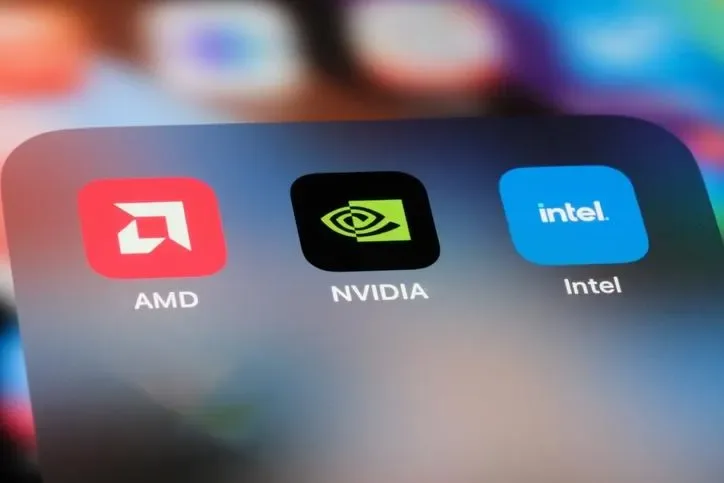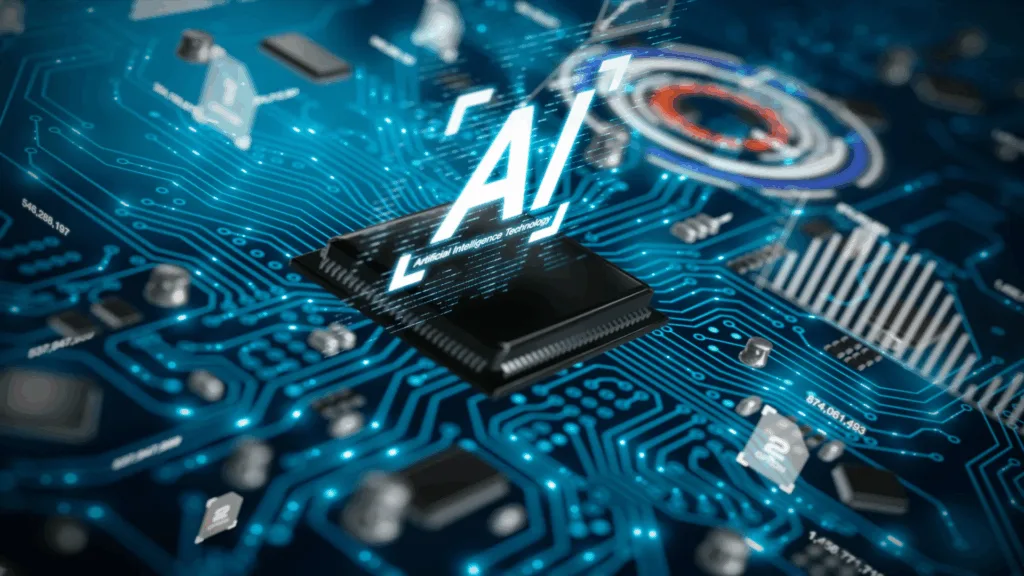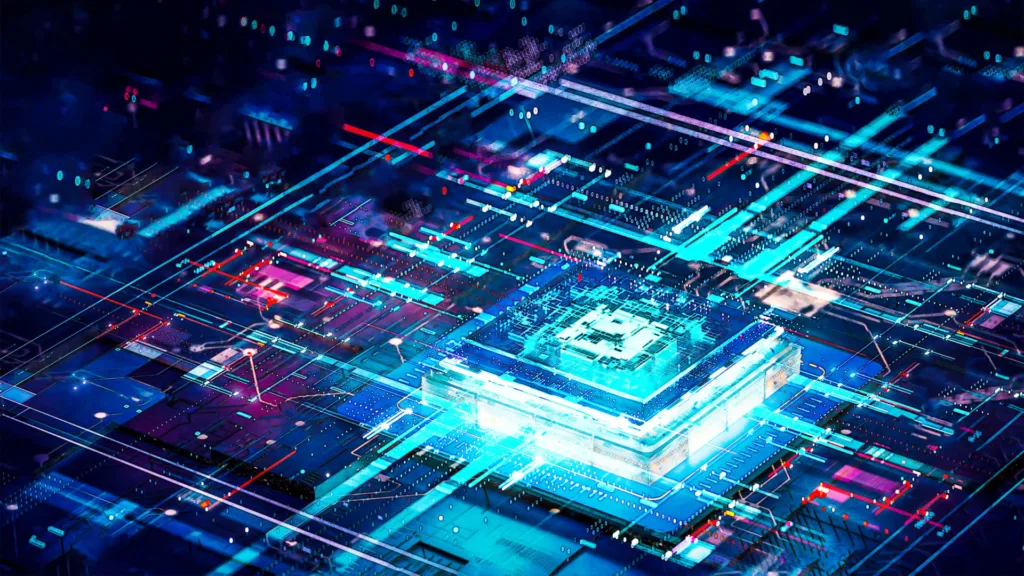
The global race to dominate artificial intelligence hardware has turned Nvidia, AMD, and Intel into the most closely watched companies in tech. As demand for AI computing power skyrockets, these chipmakers are pouring billions into new architectures, software ecosystems, and manufacturing capacity.
Their breakthroughs—and occasional setbacks—don’t just shape the future of AI, they send shockwaves through global markets, driving sharp swings in valuations and investor sentiment.
Understanding AI Chip Wars three-way battle is key to seeing where both AI technology and semiconductor stocks are headed next.
The Rise of AI Chips and Why They Matter
Artificial intelligence is no longer a research novelty—it’s a commercial arms race. Training advanced models like OpenAI’s GPT or Google’s Gemini requires chips that can process vast amounts of data in parallel, something traditional CPUs were never designed to do efficiently.
This is where AI chips—specialized GPUs, tensor processing units (TPUs), and custom accelerators—come in. They handle complex mathematical operations at lightning speed, reducing training times from months to weeks and enabling real-time inference for everything from self-driving cars to voice assistants.
The explosion of AI applications has created an unprecedented surge in demand for high-performance silicon. Data centers, cloud providers, and even sovereign governments are scrambling to secure these chips, viewing them as critical infrastructure.
Unlike general-purpose processors, AI chips are optimized for tasks such as matrix multiplications and deep-learning workloads, which gives companies that design them a major technological edge.
This growing dependence on AI hardware has also transformed financial markets. Chipmakers are no longer just semiconductor companies—they’re gatekeepers of the AI revolution.
Investors now treat every new product launch, supply constraint, or rumored breakthrough as a signal of who might lead in the trillion-dollar AI economy. The result? Increased volatility in tech stocks, as expectations swing with every earnings call or product roadmap leak.
Nvidia: Dominating the AI Chip Wars Race
Nvidia has become almost synonymous with artificial intelligence hardware. Originally known for powering graphics in gaming PCs, the company’s GPUs proved ideal for the massive parallel computations required by deep learning.
Its early bet on AI paid off spectacularly, giving Nvidia an overwhelming lead in AI accelerators used by hyperscale data centers and research labs.
Central to Nvidia’s dominance is its CUDA software platform. While competitors produce capable hardware, CUDA provides a mature ecosystem of developer tools, libraries, and frameworks that make building AI applications faster and easier.
This tight integration between hardware and software has created high switching costs for enterprises, locking many AI workloads into Nvidia’s ecosystem.
The company’s flagship products—such as the A100 and H100 GPUs—have become essential components for training large language models and other demanding AI applications.
Demand is so strong that customers often face months-long backlogs, giving Nvidia pricing power rarely seen in the semiconductor industry. These supply constraints, combined with blowout earnings reports, have made Nvidia’s stock one of the most volatile on Wall Street.
But Nvidia’s dominance is not guaranteed forever. Competitors are racing to develop rival chips, and governments are scrutinizing its market power. Still, with its aggressive product roadmap and deep relationships with cloud providers, Nvidia remains several steps ahead in performance and efficiency—cementing its role as the current king of AI silicon.
AMD’s Counterattack: Competitive Pricing and New Architectures
While Nvidia dominates the AI accelerator market, AMD has been steadily carving out its own space with a different playbook: a mix of aggressive pricing and cutting-edge architecture. Known for challenging Intel in CPUs with its Ryzen and EPYC lines, AMD is now taking the fight to Nvidia in GPUs and AI chips.
AMD’s MI300 series accelerators, designed for data center AI and high-performance computing (HPC), are built on advanced chiplet architectures that improve efficiency and scalability.
By leveraging its expertise in modular designs, AMD can roll out powerful products faster and often at a lower cost than its rivals. This price-performance advantage is especially appealing to cloud service providers and enterprises looking to avoid overpaying for AI infrastructure.
The company also benefits from strong partnerships with major players like Microsoft, Meta, and Oracle, who are eager to diversify their AI chip suppliers. These collaborations give AMD early design wins and validate its hardware as a serious alternative to Nvidia’s offerings.
Financial markets have taken notice. AMD’s announcements of new architectures often trigger sharp movements in its stock, as investors weigh whether it can close the gap with Nvidia. While it still trails in software ecosystem maturity—lacking something on par with Nvidia’s CUDA—AMD is investing heavily in ROCm (Radeon Open Compute) to attract developers and lower switching costs.
If AMD can execute its roadmap and ramp up production quickly, it may not dethrone Nvidia outright, but it could force more competitive pricing across the industry—reshaping margins, supply chains, and ultimately, AI adoption costs.
Intel’s Bid to Reclaim Relevance in the AI Era
Intel, once the undisputed leader of the semiconductor world, has found itself playing catch-up in the age of artificial intelligence. While Nvidia and AMD captured early momentum with GPUs and custom accelerators, Intel relied heavily on its traditional CPU dominance—a strategy that proved insufficient as AI workloads demanded specialized parallel processing power.
To close the gap, Intel has rolled out its Gaudi series of AI accelerators, targeting data center training and inference. While these chips have shown competitive performance at lower cost points, they’ve yet to gain the same traction or developer mindshare as Nvidia’s GPUs.
Intel’s broader AI strategy leans on its manufacturing muscle: by investing billions into expanding its fabrication facilities, the company hopes to become not just a chip designer, but the go-to foundry for others developing AI silicon.
Intel’s acquisitions, including Habana Labs (the creator of Gaudi), highlight its determination to rebuild relevance in this fast-moving market. But execution challenges, production delays, and an ecosystem still in its infancy have made investors cautious. Every roadmap update or missed milestone sends ripples through Intel’s stock price, reflecting uncertainty about whether it can successfully pivot to the AI era.
Still, Intel isn’t out of the fight. With strong relationships across enterprise and government sectors—and a commitment to open development frameworks—it could emerge as an essential counterweight to Nvidia’s dominance. If its manufacturing strategy succeeds, Intel might influence not only AI chip performance but also the global supply chain itself.
How Competition Fuels Market Volatility and What’s Next
The battle among Nvidia, AMD, and Intel isn’t just about engineering breakthroughs—it’s shaping global financial markets in real time. Every product launch, earnings report, or supply-chain update sends semiconductor stocks swinging, as investors scramble to predict who will control the future of AI hardware.
This volatility stems from how critical these chips have become. Cloud providers, startups, and even national governments view AI accelerators as strategic assets, creating demand that often outpaces supply. When Nvidia reports record sales or hints at capacity constraints, its stock can surge—or spike fear about shortages across the industry.
Conversely, when AMD unveils a new architecture at a disruptive price, markets quickly reprice expectations for Nvidia’s margins. Intel’s roadmaps add another layer of uncertainty: success in scaling its foundry business could reshape global chip production, while delays risk eroding confidence even further.
For investors, the takeaway is clear: this isn’t a calm, predictable sector. Rapid innovation cycles mean today’s leader can be challenged faster than ever, and valuations can swing wildly with each quarter’s guidance.
For businesses building AI infrastructure, the competition is both a blessing and a headache—hardware gets faster and cheaper, but supply availability and pricing remain unpredictable.
Looking ahead, three forces will likely define the next phase: continued innovation in chip architectures, diversification of supply chains to reduce bottlenecks, and increasing government involvement in securing AI technology.
Whether Nvidia maintains its lead, AMD closes the gap, or Intel engineers a comeback, one thing is certain: the AI chip wars are far from over—and the market turbulence they generate will continue to test even the steadiest investors.



